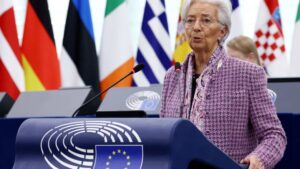ECB Rate Cut: What It Means for Europe’s Economy and Your Investments
The European Central Bank (ECB) made headlines last Thursday by cutting interest rates by 25 basis points, lowering its deposit facility rate to 2.5%. What does this mean for investors, consumers, and the European economy as a whole? At Extreme Investor Network, we break down this significant event and analyze its potential implications, providing insights that you won’t find anywhere else.
A Strategic Shift in Monetary Policy
In a notable departure from its January stance, where the ECB described its monetary policy as "restrictive," President Christine Lagarde announced that the current measures are now "meaningfully less restrictive." This change of language has been interpreted by analysts as a sign that the ECB is taking a more cautious approach to interest rate cuts.
“With new borrowing becoming less expensive for both firms and households, we are starting to see a gradual pickup in loan growth,” Lagarde explained. Despite this, she made it clear that there are no immediate plans to roll back the rate cuts. Capital Economics’ Jack Allen-Reynolds highlighted that policymakers are exhibiting caution, suggesting that while further rate cuts might be on the table, the ECB is wary of overstimulating an already fragile economy.
Positive Market Reactions
The market responded positively to the announcement, with the euro appreciating by 0.34% against the dollar. Eurozone government bond yields also experienced a rise amid a global bond sell-off, underlining a shift in investor sentiment. Investors are hopeful that a less restrictive monetary policy will bolster the sluggish Eurozone economy, especially given the current challenges posed by inflation and potential trade disruptions.
Inflation Trends: A Mixed Bag
Despite the ECB’s aim to manage inflation levels, Eurozone headline inflation remains under 3%. Recent data showcased a decrease to 2.4% in February, although this was slightly above market expectations. The central bank reiterated that the disinflation process is well underway, but domestic inflation remains a point of concern.
The ECB has adjusted its economic projections, forecasting that headline inflation will average 2.3% in 2025, with slight upward revisions attributed to energy price dynamics. The long-term picture indicates a tendency toward stability around the ECB’s medium-term target of 2%, a key metric that could influence future monetary policy.
Growth Forecasts: What Lies Ahead?
The ECB’s economic outlook is also adjusting to reflect ongoing challenges. While the regions’ GDP saw a modest increase of 0.1% in Q4, projections for growth have been downgraded. The ECB now anticipates a mere 0.9% growth in 2025, primarily due to stagnant investment and decreased exports resulting from heightened trade policy uncertainty.
Navigating Tariff Uncertainties
This rate cut comes at a time when geopolitical tensions and potential tariff impositions loom large, particularly as U.S. President Donald Trump’s administration pursues an aggressive tariff strategy. Lagarde voiced concerns about the risks to economic growth associated with these trade tensions, warning that any escalation could dampen exports and overall economic performance.
In the face of these uncertainties, European nations are under pressure to bolster their defense budgets, which could also translate into economic ramifications. Increased defense spending might have mixed effects on inflation and growth, making it essential for investors to stay informed.
The Path Ahead: Data-Dependence and Decision Making
Looking forward, Lagarde emphasized the ECB’s commitment to a data-driven approach. The Governing Council will analyze ongoing economic indicators before making any further decisions on rate adjustments. “If the data indicates the need for further cuts, we will act accordingly; similarly, if conditions suggest a pause is necessary, we will take that path,” she stated.
In Conclusion: Your Investment Strategy
For investors, the recent ECB rate cut and the subsequent economic indicators highlight the importance of a flexible and informed investment strategy. As interest rates become less restrictive, opportunities may arise in various sectors like real estate, consumer goods, and healthcare—industries that typically thrive amid favorable borrowing conditions.
At Extreme Investor Network, we are dedicated to keeping you updated with actionable insights tailored to help you navigate these fluctuating economic landscapes. Stay with us for the latest in market analysis, expert opinions, and investment strategies that can keep you ahead of the curve.

